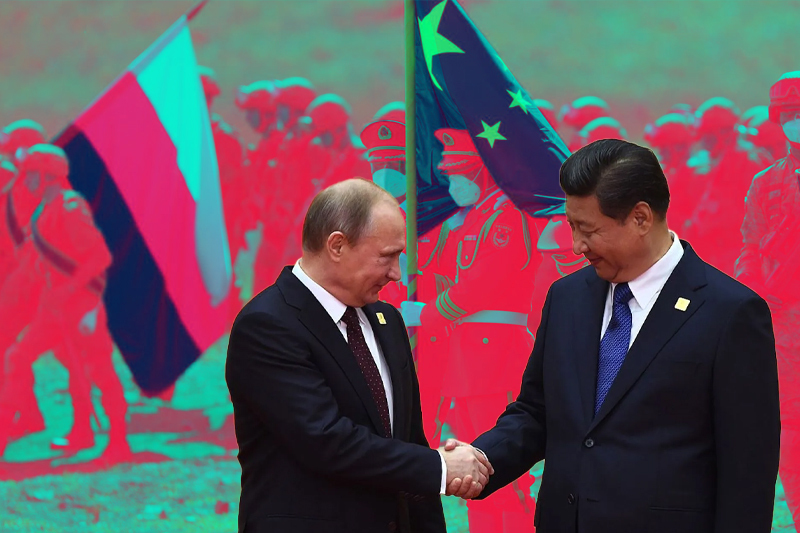
In the Asia-Pacific, China, and Russia joined forces
Beijing and Moscow believe that the US is now focusing on the Asia-Pacific region after failing to “erase” Russia.
The official visit of Chinese Defence Minister Li Shangfu to Russia from April 16 to 19 seemed to highlight the growing need for the two nations to strengthen their military ties and close coordination against the backdrop of escalating geopolitical tensions and the need to preserve the strategic balance around the world.
The important decisions reached during the intensive one-on-one discussions between Chinese President Xi Jinping and Russian President Vladimir Putin in Moscow from March 20–21 are carried forward during the visit. General Li’s four-day visit was front-loaded with a “working meeting” with Putin, breaking protocol, according to Kremlin spokesman Dmitry Peskov.
Li is no stranger to Moscow; he previously oversaw the Central Military Commission’s Equipment Development Department and was sanctioned by the US in 2018 for acquiring Russian arms, such as the Su-35 combat aircraft and S-400 surface-to-air missile systems.
Li’s trip, according to Song Zhongping, a well-known Chinese military analyst and TV commentator, will signal the close military ties between China and Russia and result in “more beneficial exchanges in many fields, including defense technologies and military exercises.”
On April 12, the US Commerce Department declared the enactment of export controls on a dozen Chinese firms for “supporting Russia’s military and defense industries.” The Global Times retaliated resolutely, saying “China and Russia are both independent major powers. It is within our discretion as to whom we will engage in customary economic and trade cooperation. We reject the finger-pointing and even economic pressure from the US.
Putin stated that military cooperation is crucial to Russia-China relations during his meeting with Li last Sunday. According to Chinese analysts, Li’s visit is also a joint message from China and Russia that pressure from the US won’t affect their military cooperation.
Putin revealed in October 2019 that Russia was assisting China in developing an early missile warning system, which would significantly improve China’s defensive capabilities.
Chinese observers noted that Russia had more experience in designing and running a system that could recognize and send alerts as soon as intercontinental ballistic missiles were launched.
Such cooperation requires a high degree of trust and may involve the integration of Chinese and Russian systems. The system integration will be advantageous to both countries; stations in Russia’s north and west could provide China with warning data, and China could do the same for Russia with information gathered at its eastern and southern stations. In other words, the two nations could design their global missile defense system.
One of the most complex and delicate subsets of defense technology is these systems. Only the US and Russia have been able to create, construct, and maintain such systems. Russia and China, two nuclear-armed nations, working closely together will undoubtedly make a significant contribution to maintaining world peace in the current environment by containing and deterring US hegemony.
Keep Reading
The fact that Li’s visit took place between April 14 and 18, when Moscow abruptly ordered a check of its Pacific Fleet’s forces, cannot be a coincidence. The worsening of the situation in the region of Taiwan served as the backdrop for the inspection.
News broke on April 17 that 200 American military advisers were being sent to Taiwan. In early April, it was revealed that the USS Nimitz, an aircraft carrier, had approached Taiwan. On April 11, the US started a 17-day military exercise in the Philippines with more than 12,000 troops.
Global Thunder in the US Last week saw the start of 23 strategic exercises at the US Air Force Global Strikes Command’s Minot Air Base in North Dakota, where training was conducted to load cruise missiles with nuclear warheads onto bombers.
The pictures showed AGM-86B cruise missiles with nuclear warheads being mounted on the underwing pylons of B-52H Stratofortress strategic bombers by the base’s flight technical staff.
Once more, it has become more and more common to see US fleet and aviation exercises close to Russian borders or in areas where Russia has geopolitical interests.
A B-52 Stratofortress allegedly flew overhead the Korean Peninsula on April 5 “in response to nuclear and missile threats from North Korea.” At the same time, the USS Nimitz took part in trilateral naval exercises between South Korea, the US, and Japan in the Sea of Japan.
Nikolai Patrushev, the secretary of the Russian Security Council, recently called attention to Japan’s expanding capacity for offensive operations, which he claimed was “a gross violation of one of the most important outcomes of the Second World War.”
The majority of the territory in the Russian Far East can be directly threatened by Japan’s planned acquisition of 500 Tomahawk cruise missiles from the US. To “protect the remote islands of Japan,” Mitsubishi Heavy Industries is developing Type 12 land-based anti-ship missiles.
Additionally, Japan is creating hypersonic weapons that it intends to use for combat operations “on remote islands,” which the Russians believe could be used by Japan to seize the Southern Kurils. Japan’s military budget for 2023 will be more than US$51 billion (equal to Russia’s), and it is expected to rise to $73 billion.
The Russian Pacific Fleet’s ships and submarines moved from their bases to the Seas of Japan, Okhotsk, and the Bering Sea during the most recent surprise inspection.
Sergei Shoigu, the Russian defense minister, said: “In practice, it is necessary to work out ways to prevent the deployment of enemy forces to the operationally important area of the Pacific Ocean – the southern part of the Sea of Okhotsk and to repel its landing on the Southern Kuril Islands and Sakhalin Island.”
The Pacific theatre of operations remains relevant, and it must be kept in mind that “the forces of the [Pacific] fleet in its components can certainly be used in conflicts in any direction,” according to Putin, who made these highly significant remarks on April 17 during a meeting with Shoigu at the Kremlin, while Li was in Moscow.
The following day, Shoigu told General Li, “I look forward to the closest and most fruitful cooperation with you in the spirit of unbreakable friendship between the nations, peoples, and the armed forces of China and Russia.
Beijing and Moscow imagine that the US is focusing on the Asia-Pacific theatre after failing to “erase” Russia. It suffices to say that Li’s visit demonstrates how complex Russia and China’s defense cooperation is in practice. Military-technical cooperation between Russia and China has always been somewhat secretive, and the level of secrecy has risen as both nations engage in more direct conflict with the US.
Beyond its technical and military significance, Putin’s 2019 statement on the joint development of a ballistic-missile early warning system had strong political overtones. It showed the world that China and Russia were edging closer to a formal military alliance, one that could be sparked if US pressure became excessive.
Putin raised the prospect of a military alliance with China in October 2020. The response from the Chinese Ministry of Foreign Affairs was favorable, despite Beijing’s decision to avoid using the word “alliance.”
If the need arose, a quick and efficient military alliance could be put together, but given their respective foreign-policy philosophies, this was unlikely. However, a paradigm shift might occur if there is a genuine and impending threat of military conflict with the US.




